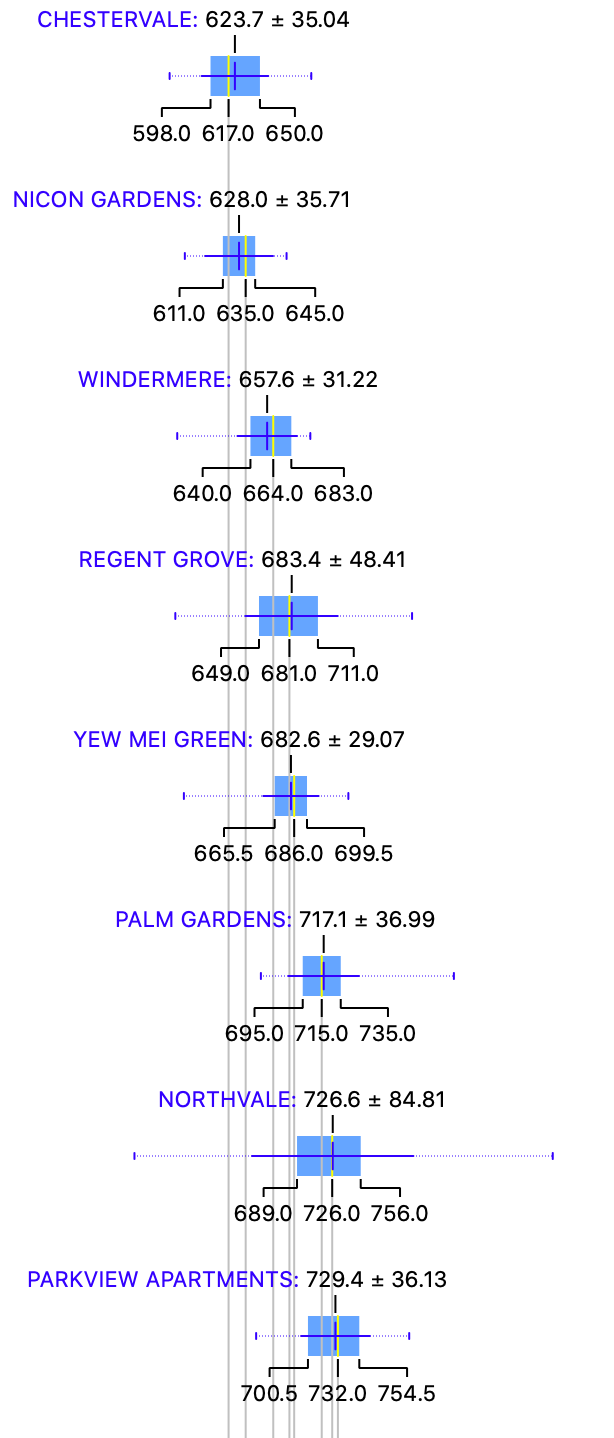
(Photo credit: Wikipedia)
Date of Analysis: 19 December 2019
Period of data: Dec 2016 to Dec 2019
Number of transactions analyzed: 3988
(transaction data extracted from URA website)
District 23 is one of the districts within the OCR (Outside Central Region) of Singapore. It comprises of few neighbourhoods such as Diary Farm, Choa Chu Kang and Bukit Panjang etc. Some of the private properties in this region are Hillion Residences, Eco Santuary, Hazel Park condominium etc. Recent new properties in the area are Midwood, Dairy Farm Residences and Mont Botanik Residences.
How do the private properties in D23 generally fare? Using box plots, here are the details for each of the properties in D23.
More box plots of other condominiums in this district (together with all the other districts) could be unlocked when you become a patron (https://www.patreon.com/datascienceinvestor)
To help you better understand the data, I will use Mont Botanik Residence as an example here. From the diagram, you can see that

Average price- $1680.5 psf
Median price- $1688 psf
Price at 25th percentile- $1644 psf
Price at 75th percentile- $1693 psf
I personally think that box plot is a good way to present the data. In this case, you can easily see the average price, median price, price at 25th percentile and price at 75th percentile from the plots. You could also tell at one glance how wide the spread of prices are for any of the condominium projects. Pretty neat, I will think.
The metric used here is $psf as it is a common indicator to reflect property prices.
The most expensive condominium in D23 is Mont Botanik Residence with an average price of $1680.5 psf while the most affordable condominium in D23 is Chestervale with an average price of $623.7 psf. Mont Botanik is freehold and one of the newest developments in D23 so no surprises here that it's the most expensive condominium. Midwood came at a close second with a median price of $1643 psf. This is even more expensive than Bukit 828 which is a freehold condominium. Guess the close walking distance to Hillview MRT do help the prices for Midwood.
Now, let's take a look at the various scatter plots to have a better insight of how the property prices perform across 3988 transactions in the past 3 years.

First, a scatter plot of the $psf against date.
In scatter plot, we could derive r coefficient, which is used to explain the strength of the linear relationship between 2 variables. Since we are using $psf and date as the variables, r coefficient allows us to better understand how the $psf changes with time. To some extent, if the r coefficient is high, we could roughly assume that the $psf increases positively with time. The r coefficient (or much simply/loosely put, the gradient for the line of best fit) in the scatter plot above is 0.28. This generally means that there is a small increment in $psf in D23 in the past 3 years.This is because new developments will usually bring up the $psf of the area as they are priced higher. This is also why your property usually increases in value when there is a new condominium development around your area.

From this line of best fit, you could also better understand if you are "over-paying" for your property purchase (eg. if you property is above the line of best fit). Taking a quick glance at the scatter plot, your transaction will be on the high side if you are paying more than $1100 psf in Oct 2018. Of course, there could be many factors such as location, tenure etc that could influence your buying price. This is still a general assumption.
So, which projects perform remarkably well comparatively in the past 3 years?

The plot above shows a myriad of lines of best fit from various different projects in D23.
3 of the top performing projects from the graph above are Hazel Park Condominium, Inz residences and Hillview Regency. Hazel Park Condominium's TOP date is in 2001 while Hillview Regency TOP's date is in 2005. As such, they could generally be considered as "older" condominiums. Interestingly, they actually perform really well as compared to the other projects in the past 3 years.

Next, how do freehold perform against leasehold during this 3 years period?

I have only included freehold transactions in this plot and you could see that the r coefficient of 0.61 is almost more than 2 times of the r coefficient of 0.28 for the scatter plot with all transactions. This means that the freehold properties actually perform even better than leasehold properties and are thus a better buy!
Also, how about apartments of various sizes? How do they perform against each other?
You could see that apartment size (between 500 and 1000sqft) performs the best or rather significantly better than properties of other sizes. Apartment of such sizes are usually 2 bedders in nature.
What you have seen above are largely data insights that we have derive using the various data science tools. But, what if we could actually use these insights to build machine learning model to attempt to predict the prices of the properties in D23 and understand if the prices the seller is asking for is reasonable? How could we do that?
We could try various different machine learning models to attempt to do so. Some examples of such machine learning models we could use are random forest and linear regression. They are methods which we could generally use to apply regression techniques to attempt to construct a linear relationship between price and various other variables (in this case, it will be project name, date of sales, size of flat etc). What we ultimately try to construct is a predictive model which allows us to have the highest confidence in prediction by attempting to reducing as much prediction errors as possible (think about Mean Absolute Error and Root Mean Squared Error)
If you are already feeling confused at this point of time, don't be as these information are highly technical in nature. You may read up more about them if you want to. Otherwise, I believe the information above in the box plots and scatter plots are more than enough for you to better understand the property prices in D23. I will also attempt to explain or illustrate more of this in a separate post in the future.
Running through all 3988 transactions through several machine learning models, I eventually achieve a model which provides me with suitable evaluation results (MAE of 23470, RMSE of 115001 and R2 of 0.985).
I then now try to put this machine learning model to practice and use it to determine what should be a reasonable price for the following property.
Project: Hillion Residences
Area: 711sqft
Floor level: High (i'm going to assume it is from level 11 to 15)
Running through the machine learning model which I have created, the price I have obtained is $980,000 which is lesser than the asking price of $1,050,000. Of course, there might be other factors in place such as furnishing status etc which is not taken into consideration and you will have to judge accordingly if you should be paying a premium for it.
Of course, the above example is just a glimpse of what is achievable as you could actually use it to determine a lot more property prices in the region. In the future, I will also consider uploading this machine learning model online so you could actually use it to determine/predict property prices based on this model. But that's a story for another day.
Now, with these data in mind, go be a data science investor!

Psst.. If you like what you read, please scroll down and subscribe for regular updates!










Comments